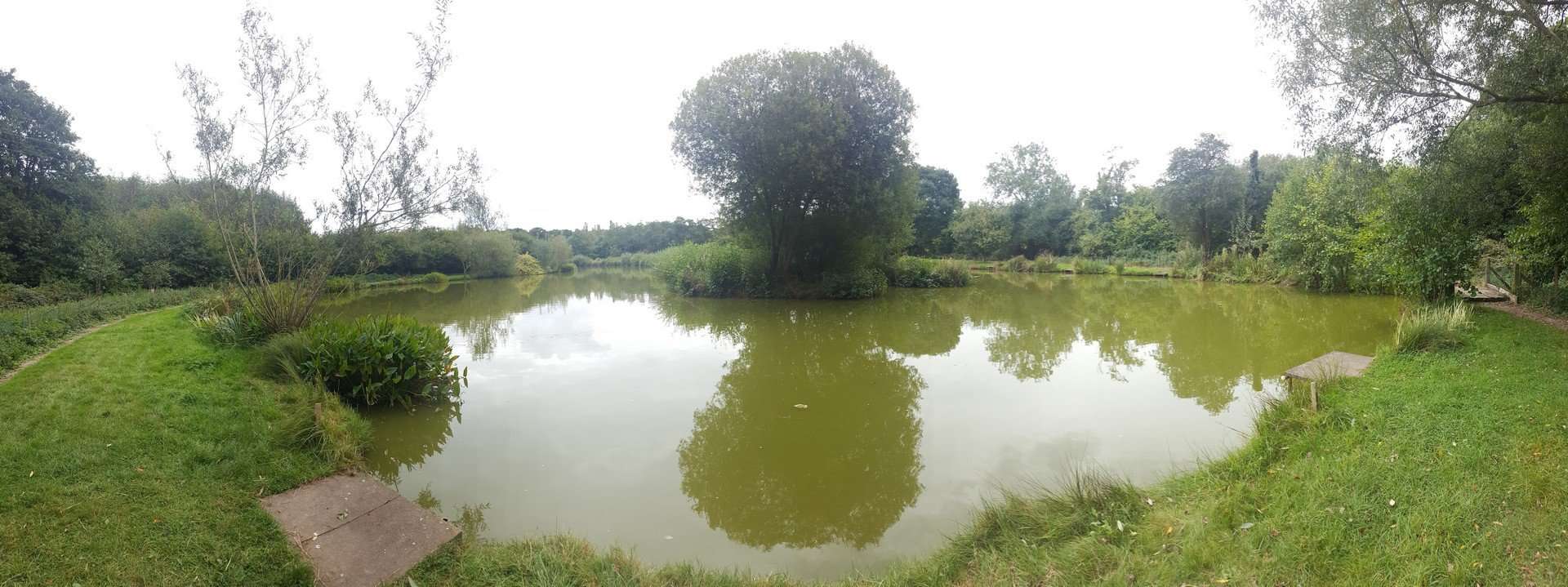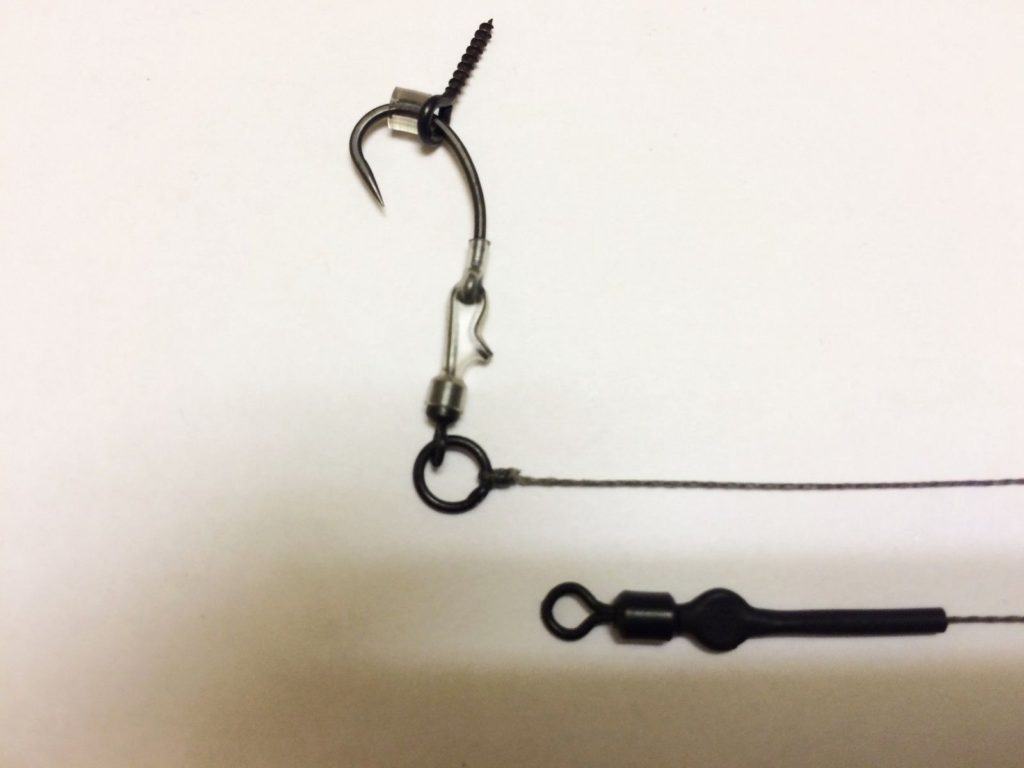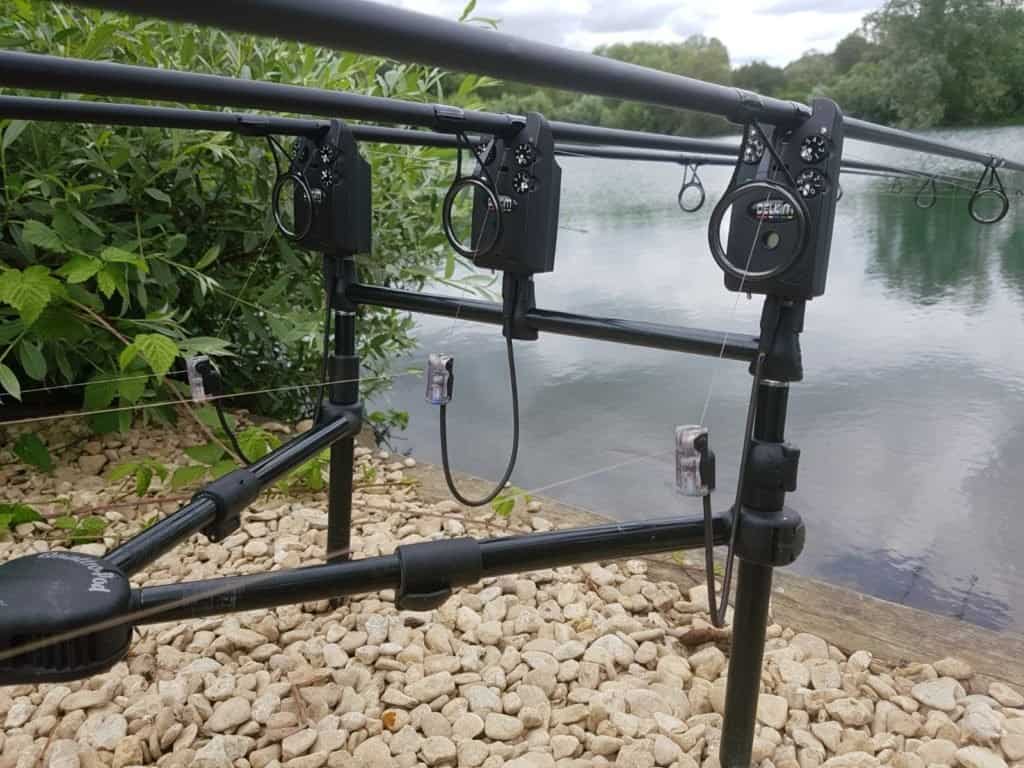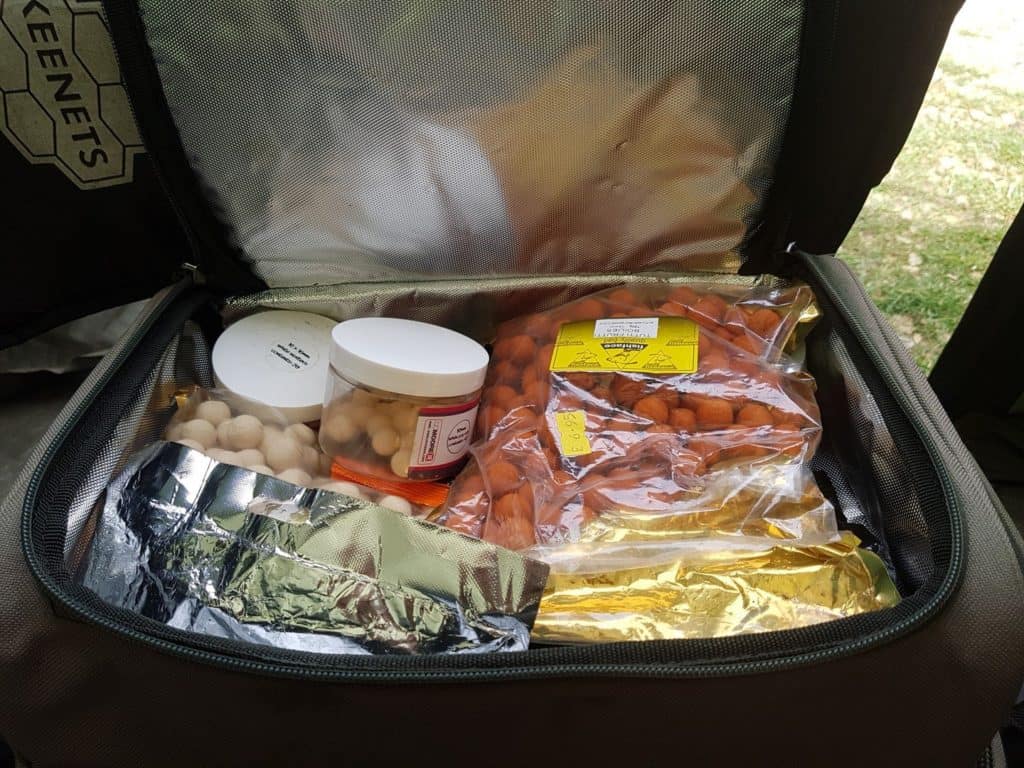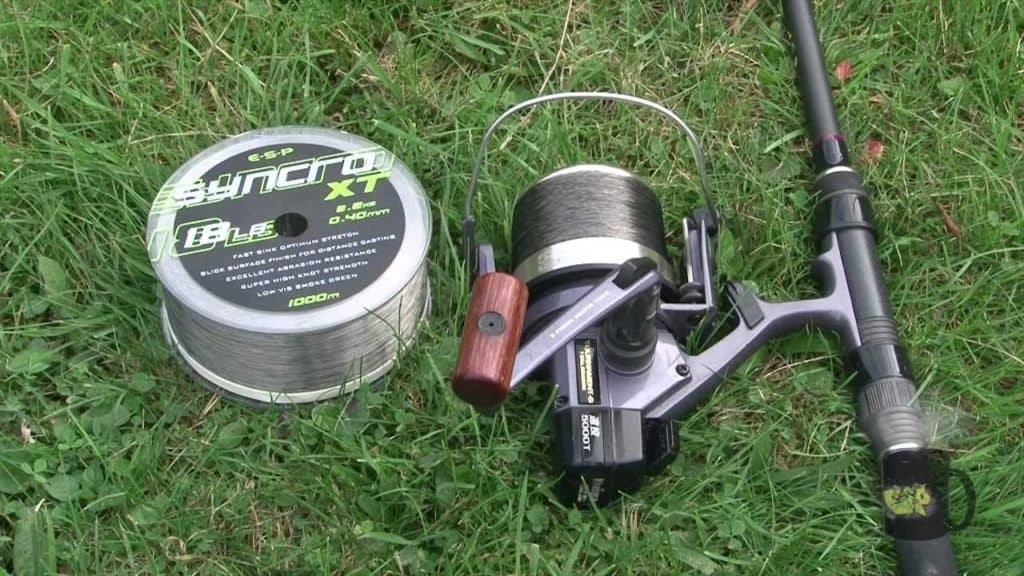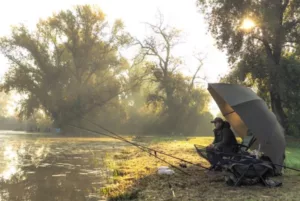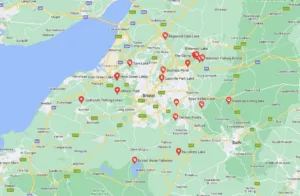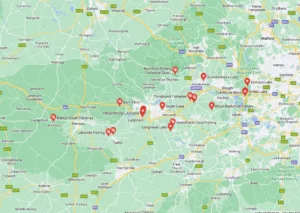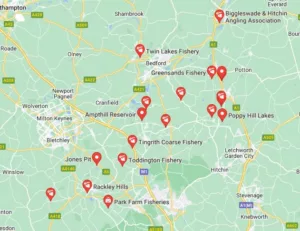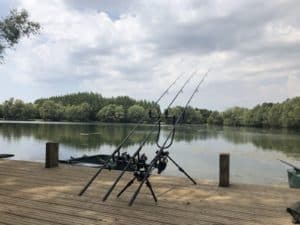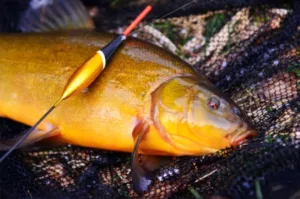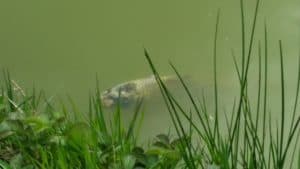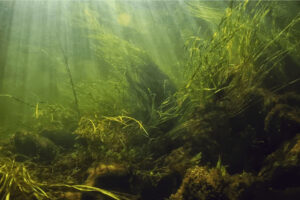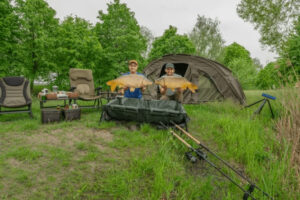How to Catch Carp in a Pond
What approach should you take to catch carp in a pond?
I would typically class a pond as a small lake that isn’t necessarily classed as a specimen lake with predominantly carp living in it, for example. The type of water that has anything and everything in it, all types of fish at a range of sizes.
Lots of small ponds as described above can hold carp up to 20lb so it’s well worth throwing in a bit a bait and seeing what you can catch.
Smaller ponds don’t need heavy tackle as they are unlikely to hold fish over 20lb.
By using light gear, fishing suddenly becomes a lot of fun again.
Follow these tips when you next approach a small pond to get the edge.
Stick it out Until the End of the Day
Fish that reside in ponds that have a constant stream of anglers will soon learn the patterns as to when the rigs come out.
Most of the time, anglers will pack up a few hours earlier than closing time.
Fish have been known to not feed in the day and then start to feed as the angler’s pack away. This is especially true when night fishing is not allowed.
If you hang around until most of angler’s pack away, you will see the bubblers starting to appear as the fish turn to feeding.
Sometimes you will be the only person on the lake, so use this time to cast at showing fish, or onto the spot where you have seen the fish being caught throughout the day.
Normally the last three hours are when it starts to really kick off.
Two-Rod Lengths Out
When anglers pack up for the day, you will see a lot of them throwing the remainder of their bait into the lake, right in front of their swim.
The fish will learn that these areas are a source of food and will find the right time to feed off it.
Try fishing two-rod lengths out in front of your swim to pick off the larger fish.
Remember to pin your line down with back leads to make sure they aren’t spooked by your fishing line.
You will also need to be quiet on the bank as the fish will literally be at your feet.
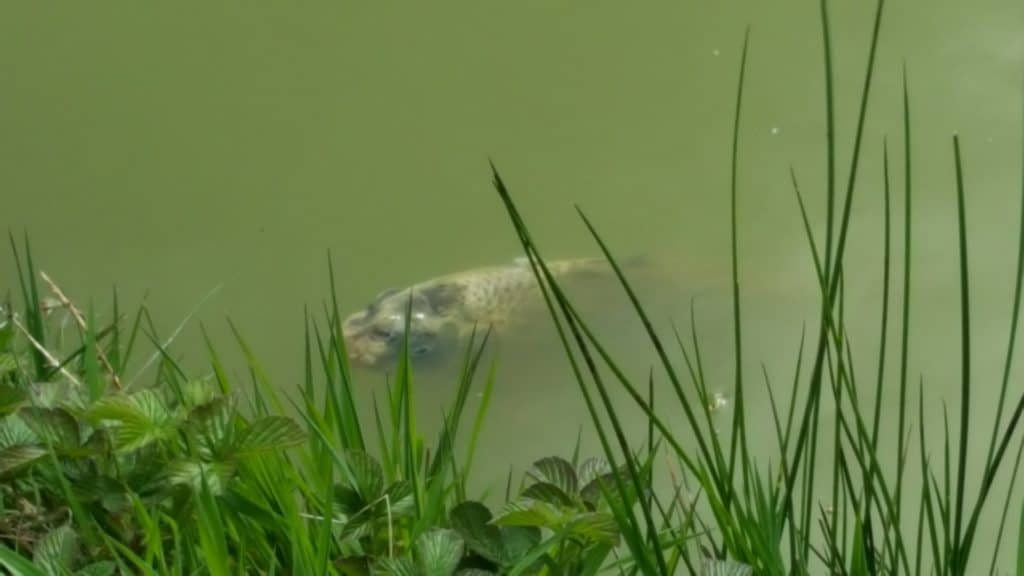
Don’t ignore the margins, the fish will feed off of the bait that anglers throw into the swim after their session
Try Stalking the Bushes
On small ponds, it is very rare to see anglers stalking, they will usually be found camped out in a swim.
Keeping mobile and hunting around for fish in the bushes and amongst the pads and rushes could score you a bonus fish.
You will need to tread lightly and dress in colored clothes that match your surrounding so that you don’t stand out.
Fish Swims that Don’t Get Fished
Overgrown swims and awkward swims can produce a lot of fish, this is because they never get fished and instead they are used as safe havens for the fish.
If you can get a fish out and have enough space to get a net into the water, then don’t overlook these areas.
Keep low in the swim and softly lower the bait into the swim, then feed bait in by hand to keep the fish feeding.
These areas can hold the biggest carp in the lake.
Don’t Be Seen
If you are wandering around looking for the fish, or trying to get a rig in place, don’t be seen by the fish.
Keep low and keep quite else you will spook them and end up just chasing them around the lake.
Anglers often don’t do themselves any favors by spooking off the fish before they’ve even started their session.
Speaking loudly, wearing bright colored shirts, banging in bivvy pegs will all send the fish to the opposite side of the lake.
So, move slowly and gently, be quiet and stay away from the edge of the water, else the fish will know you are there.
Pick a Few Off the Top
One of the most exciting methods for catching fish on small ponds is surface floater fishing.
It is nail-biting to watch the fish mouth your floating bait and then suck it in along with your hook.
If the warm weather is present and the fish are on top, see if you can get them feeding on dog biscuits or floating baits.
Bread can also be used to tempt them but will come off the hook more often than floating baits.
Although, keep in mind that you may have to feed off the birds if they start stealing the bait.
I have written an article as to how to be successful at surface floater fishing.
It may take some time, but once they start feeding it can get very exciting.
Feed a Few Spots and Watch
If there are a few different potential fishing spots in front of you, bait up each of the areas and watch for feeding.
Especially any snags, bushes, rush beds and pads, bait them up and looking for signs of carp.
When you can see the fizzing or swirls, lower a bait in gently for a quick bite.
These types of bites can happen quite quickly and rapidly if you manage to not scare off the fish.
Lower your bait in and the trickle a few pellets in little and often to pick a few fish off.
The beauty of this technique is that you don’t need lots of fishing rods or lots of gear.
One rod, a landing net, unhooking mat, tackle box and some bait and you should able to pick a fish off of each spot as the fish start feeding.
How to Catch Carp in a Lake
Fishing in a lake is different to fishing in a pond.
When fishing in a pond, the fish tend to not be too far away, but in a lake, a lot more skill is required.
You will need to hunt for the fish and use your watercraft skills to locate them before settling down in a particular swim.
A different approach is needed compared to a pond, but most of the skills can be learned quite quickly.
You will likely be targeting bigger fish, so you will need heavier tackle.
You will need a heavier fishing line and strong test curve rods so you can cast further.
You may even consider using rowing boats or bait boats to get out to where the fish are if you are fishing a large reservoir.
Here are some other tips that may help you catch fish on a lake.
Hook Link – How Long Should it Be?
Do worry so much about all of the extra rig components Danny Fairbrass told you to attach to your rig, it’s just marketing.
What is more important is the rig mechanics and the majority of rig mechanics is down to the hook length.
When most anglers are using a 6-inch hook link, try a three-inch hook link length.
You will catch the fish off guard and have more of a chance of getting one in the net.
Don’t be afraid to also try a longer hook length, a 9-12-inch hook link length has also been successful for me in the past when snaring big carp.
When you find a hook link length that works, try it on the other rigs to see if you can double or triple your success rate.
Which Bait to Use on Lakes
There are many options when it comes to bait, but choosing the right bait is important when you are figuring out how to catch carp on lakes.
Boilies seem to be the obvious choice, but don’t fail to neglect the other options.
Halibut pellet has always worked well for me. I used it when I first started carp fishing and still use it to this day.
During the winter months, I think halibut pellet has caught me more fish than boilies have.
I use single 14mm pellets and I also use double 10mm pellets topped with corn for visibility.
Being able to quickly add on a PVA stick to the hook for added attraction is a huge benefit when casting a rod out to showing fish.
But, don’t limit yourself to boilies and pellet, use can also use nuts, maggots, pepperamis and luncheon meat.
One thing match anglers do really well is to try different color baits to see what catches the fish’s attention. Carp anglers really should do this too, then try changing your other hookbaits to the winner to try and double down on your catches.
Running Rigs Instead of Semi-Fixed
I believe carp do learn to eject hooks by shaking their heads and using the lead to pull the hook free. Then at the other end, all you hear is a couple of bleeps and are none the wiser.
If you keep getting bleeps, but no runs, try running rigs instead of lead clips as a defense against the fish trying to get rid of the hook.
Having an inline lead and a buffer bead to pull the lead home, this method can very much catch the carp off guard and set the hook nice and deep.
Lead clips are very good at what they do, but if the water if not weedy and you don’t need to lose the lead, a running rig can make a difference.
Practice Until You Can Land Your Rig In a Dust Bin
Accuracy is important when it comes to catching multiple carp.
When you have found clear spots in the lake and you have confidence that fish have been feeding on the spots, you need to keep casting accurately to the spot to keep picking off the fish.
It is completely pointless spodding out 5 kilos of bait and the not casting your rig back to the baited area.
So whenever you can, practice your casting and it will pay off in the long run.
You should be using far bank markers to get your line and direction right, and then use your line clip and distance markers to get an accurate distance.
If you are fishing the same lakes and fishing spots on regular occasions, using electrical tape to mark your line, or different colored pole elastic to mark your line will help you get back to your spot accurately.
Make Lots of Notes and Write Down Any Patterns
Whether you are dedicating a season to a particular lake or only visiting a lake once, you should always be taking notes.
Most lakes have feeding patterns. There are some lakes where the fish only feed at night, some only during the day, others don’t feed at weekends due to the angling pressure.
You should be recording the time of the day as to when fish are being caught, this will highlight any patterns.
Don’t forget to note down where and when other anglers are catching too, where fish are topping out, bubblers, where they are sunbathing too.
All of this information will build up a pattern as to how the fish act, where the hold-up, where they are comfortable feeding and areas they avoid, which bait they like, do they get caught on huge beds of bait, PVA sticks or maybe even single baits?
Try your best to stagger your sleep over different sessions so you can watch the lake at different times, you need to watch the lake not only during the day but also at night and very early in the morning. I have found that on some lakes, the fish wake up early and start feeding when everybody else is asleep.
Over time, you will have a lot of information built up for you to analyze and all of that information will allow you to dominate the lake.
Fish Spook Easily Off Rigs – Get Them Hidden
When carp even get a hint of a rig, they will swim on past and go elsewhere to feed.
I learned a very valuable lesson recently at a lake on the Linear complex. I sat for four days next to the lake with three rods in the water, without a bleep from my bite alarm, not one. Yet the other anglers on the lake (who were my friends, we hired the whole lake) were catching on a regular basis.
I thought it was my bait, so I added more bait, I then tried a different bait. I thought it was the amount of bait, so I added more bait. I thought it was too much bait, so I tried different spots. But nothing worked.
On the last morning, I decided to get the FishSpy out and see what was on the bottom of the lake and to see what the lakebed was made up of.
I was shocked to learn that instead of silt on the bottom of the lake, it was a light chalky color sand. And, I had been fishing the whole time with a silt colored hooklink… A completely black hooklink. It stood out like a sore thumb.
With no surprise, as soon as I changed the hooklink to fluorocarbon, I started catching fish, although it was a little too late as I was due to leave in a few hours.
Find out what is on the lakebed with a FishSpy, I explain how to use one here, and match your rigs to the lakebed you are about to fish on top of.
Make sure the rig is pinned to the lakebed too. Tungsten putty and backleads will help you achieve this.
Every Bleep Happens for a Reason
I was fishing on an amazing lake, one that I had seen many huge 40lb+ fish be caught. But I just couldn’t seem to catch anything myself.
I would get small single bleeps from my Delkim bite alarms, but they never developed into a run.
The bobbin lift up ever so slightly, one bleep and then nothing.
On other occasions, it would drop down and bleep, but no runs.
I couldn’t figure it out and was getting really frustrated.
On one session, I invited my good friend to fish with me. He was a far better angler than me so I was watching him very carefully.
He knew each bobbin movement meant and was eagerly watching them move.
He did something very different to what I did. When the bobbin dropped, he hit the rod which resulted in a fish.
The bobbin would then pull up slightly and he would hit the rod, another fish on the bank.
Those little movements were hooked fish being very smart and not charging off, the were sitting with the hook in their mouth and then figuring out how to spit it out.
While I was watching the bobbin move, I was being done by the fish as they spit the hook back out.
How many fish did I miss out on? Probably at least 15 fish, and some of those could have been 40lb+.
Bigger fish are a lot smarter than the small ones, small fish panic and charge off resulting in a run. Whereas, big fish have been caught so many times, they know how to deal with hooks, which is another reason why they are more difficult to catch.
So what am I trying to say? On small ponds, the bite indication will likely be very obvious, but with larger lakes with wise fish, you need to be paying attention to the bite indication or you will miss fish.
This is the reason why i’m completely sold on the idea of Delkims and the way they work with vibration instead of rollers.
I had fox bite alarms which had rollers when I first started out, and I could pull on the line and they wouldn’t bleep because the roller hadn’t past the section to make it bleep.
But with Delkims, the sensitivity can be turned up when you are dealing with weary carp so you are aware of every slight bleep.
Delkims to me, are simply the best bite alarms on the market today and have been the market leader for a long time.
Size Down When You Can
There is nothing more obvious then a huge hook laying on the lake bed.
So, unless you are fishing for 80lb+ carp, you don’t need a size 6 hook.
It’s true that you should match your hook to your hook bait, but the smaller your rig components, they less blatant the rig is.
Size ten hooks are fine for 30lb+ fish providing they are made by a decent brand such as Korda.
This is also true with leads. You don’t a 4-oz lead if you are just underarm casting, a 1-oz lead is more than big enough.
Smaller swivels are very strong, so try using them instead.
Added Attraction
Added attractions such as glugs, goo or oils can draw in the fish and get the fish feeding.
I love using fish oils in the summer months to add a slick to the water and draw the fish from the upper layers down to my bottom bait.
Preparing your hook baits before a session will absorb all of the attractants and then let them out gradually throughout the session.
Using watertight pots with your hookbaits mean you can keep the baits glugged, and put them back in the glug when you change hookbaits so they don’t go to waste.
Weightless Hooks
Cancel out the weight of your hook by balancing your hookbaits.
Fish will test the weight of hookbaits when they are feeding and if something doesn’t feel right, they will spit the hookbait out.
When you cancel out the weight of the hookbait, you will lessen the suspicion and there will be a higher chance that the fish will suck the bait straight into its mouth rather than spit it straight back out.
Use cork or foam to balance a bottom bait, drill out some the center of the hookbait to insert the foam.
When using popups, add putty or leadshot to the rig to critically balance the bait.
You can also trim the hookbait away with scissors to balance it, until it sits how you want it to.
Needle Sharp Hooks – Every Single Time You Cast
Hooks can be blunted on every cast.
They will also be blunted when the fish are picking up your bait and spitting it back out.
One big knock to the hook could ruin your chances of a run because the hook simply wasn’t sharp enough and didn’t set properly.
Before every cast, you should be checking your hook point and sharpening it until it is needle-sharp, then protecting it with PVA nuggets so it doesn’t blunt when it hits the lake bed.
This could be the difference between a blank session or the best session of your life.
Best Time to Fish For Carp
I have written an article to explain the best time to fish for carp in more detail, but I’ll go through a quick summary with you here.
Best Time of the Year to Catch Carp – Seasons
In terms of seasons, colder months are certainly proven to be more difficult to catch than the warmer months as fish tend to hold up in the colder month and not feed as much.
During the winter months, carp will tend to hibernate and be very dormant.
Whereas when the warm weather is about, you will see the fish moving around the lake, some will be seen doing laps of the lakes.
During spring, the fish will start waking up and wanting to feed, but this is also when fish will spawn, so there will be a period of time when a lake pretty much shuts down.
Summer months will likely be the more productive time when it comes to fish feeding as they will be very active. Although if it gets too hot, the fish will just sunbathe and it will be almost impossible to get them to feed during the hot part of the day.
Autumn is my favorite time to catch fish, most of the summer anglers have stopped fishing for the season, leaving the lake to me.
Autumn is when they will really hunt for food in preparation for winter and hibernation, if you can find the fish, you will likely have very productive sessions.
Best Times of the Day to Catch Carp
- First few hours of sunrise
- Last few hours of before sunset
For me, I have always found that all lakes have patterns as I explained in this article above.
You will need to learn the patterns of the lake to figure out the best time to catch carp, but to give you an idea as to my experience, I’ll talk about the patterns I have found on lakes I have fished.
For most of the lakes I have fished, the early mornings and late evenings have been my busiest times for ledger fishing.
Midday is normally the hottest time of the day and the fish will tend to move up in the layers is water to absorb the heat, so around midday is a good time for zig rig fishing and surface floater fishing.
I haven’t caught a lot of fish during the night, it’s probably because I’m not a keen night angler, but most of my fish have been during the day.
Each lake is going to be different and it’s up to you to spend the time at the lake, to learn those patterns and figure them out.
On runs waters, you will get fish picking up your bait throughout the whole day as the fish will more than likely be suicidal. On bigger lakes, there will be results comparative to the amount of effort you put in.
What you have to remember is that all lakes have different fishing pressures, mainly from anglers but also from wind directions and other weather conditions. Which is why feeding times will differ between lakes.
Be sure to make notes as I mentioned in this article, to learn the lake and use it to your advantage over time.
Best Bait to Catch Carp
When it comes to the best bait to catch carp, most traditional baits will work as carp are so curious.
But when it comes to specimen carp, boilies will be the choice for 90% of anglers today.
The quality of boilies these days, they are better than they have ever been.
Boilies are also practical for most anglers as they are easy to get hold of and are available in all different shapes, sizes and flavours.
The leading brands such as Nash, Dynamite, Mainline, and Sticky Baits are affordable and last a long time in the shelf life version.
These baits are used and supported by the top anglers because they have a proven background in catching a lot of carp.
Other top baits include maize, sweetcorn, pellet, nuts, particles such as hemp, luncheon meat, bloodworm, maggots and floating baits like dog biscuit. I have even been successful with cheese.
Maize works great as a hookbait as other fish such as bream tend to leave it alone. Sweetcorn is a complimentary bait to maize, but any and every fish loves sweetcorn, so expect lots of bleeps from nuisance fish.
Sweetcorn does melt PVA so you will need to put it into groundbait to let the groundbait soak the moisture up, or add it to salt water to stop the PVA from melting.
Maize and hemp need to be prepared in boiling water before use as it will expand in the carp gut when eaten and could kill the fish. You can buy prepared baits from local tackle shops to save the effort of preparing baits. I personally think it is well worth the month to save the stress and mess of having to prepare the bait yourself.
Carp absolutely love bloodworm, so adding it to your groundbait and spod mix will send the carp wild.
Floating baits are great for the summer while surface floater fishing. You can either buy dog biscuit and use that to get the interest of the fish, although these baits do take on water and swell up.
Instead, you can buy actual floating baits in the form of pellets, but they are a little more expensive than dog biscuit, although worth the extra money. Be sure to feed of the wildlife off with cheap bread rather than your more expensive pellets.
Luncheon meat is a fantastic alternative hookbait, as is pepperami. Fish love luncheon meat. Be sure to fry it to toughen the outer edge before using it else the fish will suck it off of the hook without you knowing.
Cheese is also a great alternative hookbait. Cut a cube of cheese such as cheddar into a 1-cm square and either use a pellet band around it or simply push your hook through it like you would do with bread, but ensuring the hook point is visible.
Maggots will get the carp’s attention very quickly and they can completely turn a session around in the winter months. Mixed into spod mixes and groundbaits, they can be extremely effective because no fish can resist maggots.
All lakes are different, and some baits will work better on others, but you need to find a bait that you are confident in and adapt from there.
I fished a lake for months on boilies and had a few fish, but I got to know the bailiff and he revealed that the fish like two 10mm pellets with a piece of yellow corn on top and that completely changed my catch rate for the better. I had tons of fish off of that combination, but on other lakes that set up didn’t work.
You can see that video here.
Best Carp Set Up
The best carp setup is one you are comfortable with.
It’s not about having the most expensive tackle, it’s irrelevant how much you spend, it’s about being able to do everything you need to do and not missing out from not having the right equipment.
With regards to what you need, here is a basic list of what you need for what I will call “pleasure fishing”. We will then go through the additional items you will need for specimen fishing and the night fishing.
This is a general guide and should be adjusted to suit your needs.
Basic Carp Equipment List for Pleasure Fishing
Coarse Fishing License
This is the most important part of your fishing equipment. You cannot fish without one unless you are on a private lake, go here to purchase one before you head to the lake. You could be fined a lot of money if you fish without one.
1 or 2 Carp Fishing Rods
The fishing rods should be between 1.75lb test curve to 2.5lb test curve.
Most carp fishing rods are typically 12ft.
You could buy feeder rods of barbel rods for general carp fishing, but if you get carp rods, you can use these for specimen fishing too.
1 or 2 Carp Fishing Reels
There are tons and tons of different carp reels to choose from, and it “reely” can be quite confusing. Especially when it comes to sizes.
You can make a huge mistake and buy a cheap Chinese reel, but it won’t pay off in the long run.
When it comes to rods and reels, you should stick with well-known brands and I advise you not to buy cheap reels.
If there is any part of fishing equipment were you should not penny-pinch, it’s the rods and reels.
If you look at a reel similar to the Shimano 10000ST Bait Runner, you will be able to use these to start, and for specimen fishing too.
4000 size reels a nice with light rods, but aren’t practical when it comes to catching larger carp as you will want winding power of the reel.
Fishing Line
Fishing line can also be confusing, but a well-branded mono in 8lb will be a good start for pleasure carping.
Try to stay away from fluorocarbon and braid if you are just starting out as it can be quite unforgiving due to not having as much stretch as the monofilament.
Take a note as to how many meters of line can fit on your reels when you buy fishing line.
Obviously, if you have two reels, you will need enough line on the spool to fill both of them.
Sometimes, on some lakes, there is a minimum line breaking strain, so make sure you check the rules of the lake before you start fishing.
Hooks
When you are pleasure fishing for carp specifically if you only have single figure fish in the lake you are fishing, you could use a hook between size 14 to size 10.
It’s unusual to have a hook larger than that for small fish.
But when you have a chance of catching larger fish, you may need to go up to a size 8.
Some anglers fish a size 6 or 4, but to me, this is completely unnecessary.
The most important aspect to hooks is that it is pinpoint sharp.
Hooks from brands such as Korda, Korum, Fox, and Nash are good hooks and always sharp out of the packet.
Lead Clips
Lead clips are a method of creating a safe rig.
To create a safe rig, the lead must be able to separate from the rig if a fish gets snagged or if the fishing line breaks.
They are very easy to use and should be used for most of your ledger fishing rigs.
There are lots of different brands but you need to make sure the tail rubber comes off easily when it needs to.
You are also able to different colors or lead clip, so be sure to match your lead clip with the color of whatever you are fishing on.
Leads
Leads come in all colors, shapes, sizes, and textures, and all serve different purposes and work in different ways.
Again, with pleasure angling, a 1-oz lead to 2-oz lead as a flat pear shape will work fine in most circumstances.
If you are needing to cast a long way, you may be better off with a distance lead, but be careful of using distance leads if the lake bed is soft, as it will dig into the lakebed and cause the rig to act in funny ways.
You will need a gripper lead if you want to do any markering to see what is on the lake bed.
Bait
I mentioned bait above in a little bit of depth, but for pleasure fishing, starting boilies is the easiest option, especially if you buy shelf life boilies.
The problem with shelf-life boilies is that they aren’t as appetizing as a maggot or sweetcorn to a passing fish.
Sweetcorn is a better bait when used for float fishing as it is quite soft and can be sucked off of the hair of the rig by a carp, resulting in you sitting with no bait on your rig and no knowing about it.
So, I would suggest using a boilie as a hook bait, and then having sweetcorn, maggots, and particles to entice the fish in to pick up your hook bait.
Introducing groundbait into the swim with particles can encourage the fish to grub around looking for the bait, so using groundbait will increase your chances of catching carp.
Boilie Stoppers
Boilie stoppers are used to hold bait, such as boilies, on the hair of a hair rig.
Back when I started fishing, you could only buy one type, but now you can buy different variations, mainly extender bait stops which allow you to adjust the length of the hair without having to tie a new rig.
You can also buy toppers, bait toppers are colored pieces of plastic, sometimes in a dome shape, but also sometimes in the shape of imitation corn and even imitation maggots.
Topper’s hook on to your hair and then the boilie is pulled up tight to it so gives the bait added attraction and mainly a fleck of color.
Quickstops are another variation of a bait stopper. You tie them onto the hair when you are tying the rig. You then push the quickstop through the bait, then turn the quickstop 90 degrees and pull the bait tight up to the quickstop to hold it all in place.
Baiting Needles
There are some really terrible, cheap baiting needles on the market at the moment.
Most of them are eBay specials from China, but they break very quickly and a complete waste of money.
If your baiting needle breaks while on a session, you will find it very difficult to put bait on to your rigs.
So don’t overlook good rig tools for your tackle box.
Another thing to not overlook is predrilling hard baits.
Not predrilling contributed towards most of my broken rig tools.
I highly recommend the Korda baiting needle set as they have lasted the longest for me.
There are five different needles in the set and all have different uses, although each of them is very similar to the others. You can also get a rig puller, although I suggest buying two rig puller so you can get one on each end of the rig.
The five needles are (and the rig puller):
- The Stringer Bait Needle
- The Leadcore Bait Needle
- The Fine Bait Needle
- The Heavy Latch Bait Needle
- The Braid Bait Needle
- The Rig Puller
Baiting Drill
A bait drill is very useful for hard baits such as 14mm halibut pellets and hard boilies, otherwise, you will break your baiting needles.
Swivels
Swivels aren’t hugely required, but they will help with rig mechanics and are necessary for certain rigs such as the chod rig. They are mainly used to stop tangles for rigs.
Quick Links
Quick links are also not required, but useful for connecting rigs to the mainline. They are extremely useful if you have rigs already tied, and need to connect them quickly if the session gets busy. If you have rigs already tied in your rig book, its a simple case of clipping them on when you get to the bank.
Scissors
They are lots of scissors on the market, but again, Korda razor blades are simply the best when it comes to cutting braid. All of the other scissors I have tried, make a mess of the braid, whereas the razor blades leave a clean cut every time.
Disgorgers
Disgorgers are definitely important as much as me to say you should have these actually in your pocket whilst you are fishing so that you have them to hand at a moments notice.
Because the way carp suck the bait in, sometimes quite vigorously, you need to have tools available to get the hook back out, no matter how deep into the mouth it has gone.
Forceps
Where disgorgers can’t reach, the forceps will. A 6-inch pair of forceps will be ok for most of your fishing, having a pair a little longer will be needed at times.
Hooklink
I use N-Trap Soft Coated Hooklink and it has never let me down.
Other hook links I have used have snapped at the knot, sometimes with a fish on the end.
So now, I only use N-Trap.
Net
For single figure carp, a strong 36-inch net is sufficient, but when you start catching doubles or bigger, you should use a 42-inch net.
Use a fine mesh to make sure the fish’s fins don’t get caught up in the net.
Extending net poles are useful, but not as strong as a fixed length net pole.
You should consider buying a net float too, they make it a lot easier to use the net when your rod is in your other hand and puts the net in the right position for when you need to scoop up the fish in the net.
Unhooking Mat
You have a few choices when it comes to unhooking mats.
- The standard flat unhooking mat which comes in different sizes.
- The unhooking cradles, which is easier for larger fish.
- The raised unhooking cradle which elevates the fish off of the floor.
Weighing Scales
If there is one thing you should learn from this whole article, it is this.
Don’t use luggage scales for carp fishing.
Buy a decent set from Daiwa or Reuben Heaton and they will last a lifetime.
5-Liter Bucket
You will need the bucket to wet down your unhooking mat when you catch a fish.
Although it can also be used to mix your spod mix and groundbait.
They have many uses, and you might want to even consider having a couple spare.
Rod Pod or Bank Sticks
A rod pod and bank sticks both have their uses.
I mainly use a rod pod as they look neat and make your swim tidy, but on occasions, I will need bank sticks so that I can fish my rods at an awkward angle, or if the swim is tight, I will put bank sticks to each of the sides so that I have enough space to walk between the rods with the net to scoop up the fish.
Bite Alarms
I used to have fox bite alarms, which had the rollers. But during one of my sessions, I noticed the line being pulled and played with, but the alarm didn’t go off.
That movement of the line could have been a personal best fish, but I’ll never ever know because, by the time I realized what was going on, the fish had gone.
Since then, I only use Delkim bite alarms because it uses vibrations to set the alarms off rather than using rollers.
Bite Alarm Receiver
The Delkim bite alarm works with the Delkim RX receiver.
The receiver is unnecessary as I am barely away from my rods, but I do like the idea of having the RX vibrating to indicate a bite so that I can turn down the bite alarms at the lakeside.
Bobbins / Bite Indicators
Because I have the Delkim bite alarms, I use the Nightlight pro hangers which light up when the alarm goes off, making it easy to see what alarm has been triggered.
Tackle Box
When it comes to tackle boxes, any strong type will do.
The main thing to consider is, are there enough compartments, and does it fit in your fishing bag easily.
The one I have is a slightly tight fit, which is a pain, but it does fit with a bit of a push, so it will do.
Tackle Bag
Daiwa sell really nice bags, they have a compact version and a larger version for longer sessions.
But, I think Korum make the best bags personally, I have a Korum bag that fits my day session kit in it and also has a cool bag section for my bait.
Back Leads
Most back leads do the same thing, so I don’t need to suggest a certain brand.
But they are great for pinning the rig to the ground. Although before you use them, you need to know what the line is going to be laying on.
If there is heavy weed in front of you, back leads may not be the best option as it will lift your rig off of the lake bottom.
This is especially true for chod rigs and helicopter rigs. You should never use them for zig rigs either.
Chair
You could use a camping chair, but most of the time, the bank you are fishing is not level, and the one feature a good fishing chair has, it’s telescopic and extending legs with wide feet, meaning you can set your chair level, no matter how uneven the ground is.
Another feature of specific fishing chairs is that they are lightweight and easy to clean.
So I do advise getting a fishing chair.
If you have a Korum fishing bag, I would advise getting a Korum fishing chair as they clip on to most of the fishing bags, so really handy if you are an angler that likes to move around the lake looking for fish.
Umbrella
Sometimes you don’t need a shelter, sometimes all you need is cover from the rain for a little while.
I use a golf umbrella because it fits in my main rod bag.
Shelter
When you are expecting more than just a short shower, you will need a proper shelter to save yourself from the rain.
Fishing Brollies are really easy to pop up and pack away quite well. Some also have overwraps that turn the brolly into a full system that you can zip up and sleep under.
Bivvys come in all shapes and sizes, but the main bivvys are 1 man and 2 man bivvys.
Most are easy to erect and have overwraps to keep them extra warm in the winter. Others have extra features such as groundsheets to keep the inside clean and dry, others have air vents to keep them cool in the summer.
A lot of bivvys have zippable front sections that are interchangeable from solid material, to clear material, to mesh.
PVA Products
I have a full article on PVA products here.
PVA can really help you get your bait presented well on the lake bed. PVA is used by a lot of anglers these days in lots of different forms.
Catapult
When it comes to catapults, you will need a long-range catapult and a short-range catapult. Don’t mistake the two.
A short-range catapult has a softer, more stretchy elastic and if you try to use it for long range, the handle will likely snap, or the elastic will likely snap.
Short-range catapults are to be used up to 30-yards and shouldn’t be used for anything further than that.
A long-range catapult is bulkier and has a stronger elastic. They are very difficult to be accurate with at short-range.
If you want to throw boilies a long way than a boilie thrower will be the better option.
The other thing to consider with catapults is the pouch. A soft pouch should be used with boilies. It’s very difficult to be accurate with maggots and corn using a catapult with a soft pouch.
The harder pouch will hold the maggots and corn better as they are a soft bait.
Lighter or Matches
You will need a lighter to shrink tubing if you haven’t got a kettle.
A lighter will also be used for blobbing the ends of fishing line for chod rigs for example.
Chances are, you will also need one for your kettle and your barbeque too, so its handy to have one in your tackle boxes.
Matches aren’t ideal, but do the same job poorly, so handy to have as a backup.
Carp Care Kit
I really should have put this to the top of the list.
I have a whole article of carp care kits here.
Every angler should have one without fail and they should be used to treat any wounds the fish has, as well as any damage on its body including lifted scales and hook holes.
First Aid Kit
Accidents happen, and a having a plaster in your bag may save you an infected finger.
Let’s face it, lakes aren’t exactly the cleanest of places, so a small cut could get infected very quickly if it isn’t taken care of.
Swiss Army Knife / Sharp Knife
Knives are useful in general, on the bank, they aren’t mainly used for cooking, but are often used in emergencies, if you catch my drift – you never know when you might need one.
Rod Holdall
Rod holdalls come in different shapes and sizes.
I used to use a three-rod holdall, but I found that quite bulky when I changed to a smaller car.
I now use single skins for each of my rods, making it easier to stack them in the car.
Carp Equipment List for Specimen Carp Fishing
Carp equipment for specimen carp fishing is as above, but there are a few items that need to be stronger, and some additional items you will need to catch the larger 20lb+ carp.
1 or 2 Heavier Fishing Rods
You need heavier rods when you are hunting larger carp.
Anywhere between 2.5lbs test curve to 3.5lbs test curve is what you should be looking for.
1 or 2 Heavier Fishing Reels
You also need heavier reels.
Ideally, you should ditch the bait runners and get some big pit reels.
This is because the big pit reels have longer handles and bigger spools, meaning you can recover the line a lot quicker when reeling in the carp.
You will also be able to cast further with a big pit reel, making it easy to punch one out further into the lake.
Heavy Fishing Line
A heavier fishing line is a must when casting further.
It will be easier for the fish to see as a heavier line is usually thicker, but a line around 15-18lb breaking strain should be considered.
Large Unhooking Mat or Cradle
When fishing for bigger fish, you will need a mat or cradle big enough to hold the carp safely.
It will need to be big enough to allow the carp to flap around too, should it need to.
Weighing Scales
Those trusty luggage scales will be no good when you are weighing 30lb carp.
You are fishing for some serious fish now when fishing in big lakes, so make sure you have the proper weighing scales to do the job.
Daiwa or Reuben Heaton are the best scales on the market.
42-inch or 50-inch Net
As with the unhooking mat, bigger fish, bigger net required.
You will also find that on some lakes, they required you to have a minimum of a 42-inch net and you will not be allowed to fish without one.
If there is a chance that you might catch catfish at the lake you are fishing, you will need a 50-inch net to fit the whole of their body in. Remember just because you aren’t targeting them, doesn’t mean you won’t catch one, so be prepared.
Bait Boat (optional)
These are great fun to use, but also useful tools when used correctly.
Most reputable bait boats of the market are good (except the Chinese boats on eBay), so choose one that suits your requirements.
Remember, if you are fishing out quite far, you will need a bigger bait boat as they can go out of sight very quickly in a big lake. And once they and far out, it can be very difficult to see whether it is coming towards you or going away from, possibly resulting in it going out of range and you having to swim in the lake to go and fetch it back.
Braid Fishing Line
A braided fishing line is a must for spodding and market float work.
Some anglers prefer to fish with a braid over monofilament and fluorocarbon, but a lot of lakes have banned it these days as a mainline.
Shock Leader
These are paramount if you are fishing over 100 yards. If you are casting hard and your line snaps, you are putting other anglers on the other side of the bank at risk of a lead hitting them, so invest in shock leaders.
Silicone Rig Tubing
Silicone rig tubing is used to stop the mainline from lifting the scales of the carp when hooked. A safe zone shock leader can have the same result killing two birds with one stone.
Rig tubing is also used to camouflage your fishing line, but you need to know what type of lake bed and color of lake bed you are fishing on to be able to match the color and camouflage it properly.
Rig Putty / Lead Shot
Rig putty is necessary for certain rigs and required to make the rigs work how they are designed.
Lead shot is another alternative but is generally used more for float fishing.
Marker Rod
If you are fishing in a lake, the chances are you are looking to catch larger fish.
This, in turn means that you will need to be finding where the fish are feeding and locating their dinner plates on the lake bed.
A marker rod will help you to find these locations.
When looking for a marker rod, make sure you buy one that can be cast further than your fishing rods or you will be restricting yourself when it comes to distance.
Marker Float
I use a dropzone float set as it comes with the interchangeable head. Find one you like the look of and stick with it.
Spod Rod
The spod rod works on the same principle as the marker rod.
You need to be able to cast as far as your fishing rods else you wont be able to put the bait where you want it.
Spod or Spomb
A spod or spomb makes baiting up so much easy.
They are used to get bait out to your spot, but make sure your rod, reel, and line are up to the job of taking that much weigh when casting one of these out as they can weigh quite a lot.
It is very easy to have one crack off if your line is not up to the job, making it dangerous for the angler opposite you.
They come in all shape and sizes, but have a handful of variations in your bag will help you approach baiting up differently as and when you need to.
Wheel Barrow (optional)
These make things easier when you have lots of equipment but can take up a lot of space in your car.
Ideally, you won’t have lots of gear on a day session so you should be able to carry it all, without the need for a barrow.
But when it comes to night sessions, they are useful to have.
FishSpy (optional)
I love the FishSpy.
The FishSpy helped me catch my PB, by showing me what lakebed I was fishing on and allowing me to change my rig to match the lakebed.
I swear by them and they are so cheap now, it’s worth having one in your tackle bag.
Deeper FishFinder Pro (optional)
I am a very visual and technical guy, so when I am at a lake, I want as much information as possible, and the Deeper FishFinder gives me that information.
A lot of the time, lakebeds are dead flat. But, knowing how deep the lake is, and seeing where the less flat spots are, gives you a really clear picture in your mind as to what is out in front of you.
The more information you can get from a lake, the more choices you can make when it comes to making decisions as to how to approach the lake.
Equipment List for Night Fishing
Head Torches and Lights
Having a head torch that has a red light setting is really useful at night.
A bright white light will spook the fish, but it will also blind the other anglers, whereas the red light gives enough light for you to see what you are doing and is more subtle than the white light.
Camping Bed
You must buy a good, comfy camping bed. I suffered for many years trying to scape by on a cheap camping bed and it killed my back.
I never had a good nights sleep on that bed and regret ever buying it.
Invest in a comfy bed.
Sleeping Bag
This was another mistake of mine.
I used a sleeping bag that came free with my bivvy, but it was terrible in the winter.
I use to have to wear my shoes and socks to bed else I would be woken by my freezing cold feet in the morning, and have to go for a walk around the lake to warm myself up (true story).
Cooking Equipment
I have a huge article on Cooking on the Bank here.
That article covers how, why, what, who and where when it comes to cooking, so check that out after this article.
Cleaning Products for Cooking
Simple cleaning products, such as the products you have at home are useful if you want to preserve your equipment.
A simple surface spray for kitchens and washing up liquid go a long way when you are on the bank.
Lots of different cloths and paper towels are also useful when cooking and keeping things clean, especially on wet sessions in the winter.
Hand Towels
You will, no doubt, get wet when on the bank.
Your hands will also get mucky when handling fish.
But able to dry your hands on the bank is a luxury, and it’s horrible when you don’t have a towel to dry them off.
So put a couple in your tackle bag.
Tables for Cooking
Foldable benches and small camping tables are available on Amazon and can be very useful for all types of storage, especially when cooking.
When I am fishing with a lot of friends, we have a barbeque together each evening so we can catch up on how it has been for the day, so having a bench there makes it more of a social event.
Portable Toilet
All I can say is, some of the lake toilets I have seen are quite frankly disgusting, so consider buying a pop-up toilet tent, and a portable toilet for when it’s needed.
It’s not the nicest subject, but when you are desparate for the loo, and the lake loo isn’t working, you will be thankful for having your own nearby.
Power Banks and Battery Chargers or Solar Panels
Power banks and solar panels are very handy for long sessions.
You can’t beat them for keeping your devices topped up over long sessions.
Portable Shower
Portable showers are now available on Amazon and are charged by USB.
Most of them are hung up from a tree or a popup shower tent, and then a pump with the feed tube is put into a bucket or water (not lake water, bottled water).
This will give you a nice, fresh shower, albeit probably cold.
Hand Sanitiser
Killing bacteria is another important thing when on the bank, there are all sorts of parasites in the water and each time you put your hands in the water or come in contact with the water, you are at risk.
Baby Wipes
Keeping your hands, face, and body is important when doing longer sessions. Not only for your sanity, but for your health.
Keep a small pack in your bag for when you need them.
I have made a lot of mistakes during my fishing sessions and don’t want you to make the same mistakes. I’ve learned the hard way over 20 years of fishing most weekends, testing, tweaking, and testing again and now want to help you excel with your carp fishing.
If you need any help, you can reach me at Fishing Again’s Facebook page
Last Updated on February 8, 2024 by Shane

